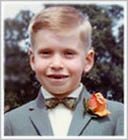An Illustrated History of Old Sutton in St Helens, Lancashire
Part 3 (of 95 parts) - Michael Hughes of Sherdley Hall
Researched and Written by Stephen Wainwright ©MMXX Contact Me
Researched & Written by Stephen Wainwright ©MMXX
Old Sutton in St Helens
of Sherdley Hall
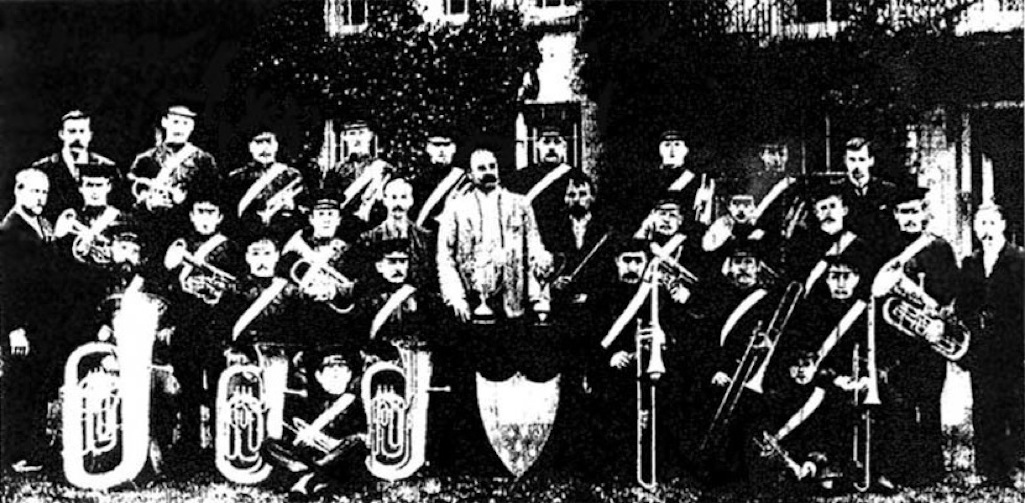
Michael Hughes III {1861-1938} with Sutton Road Prize Band pictured outside Sherdley Hall about 1902

Michael Hughes III with Sutton Road Prize Band outside Sherdley Hall

Michael Hughes III and the Sutton Road Prize Band outside Sherdley Hall
Twenty-eight year-old Hughes had arrived in St Helens during September of 1779 as controller of the new smelting division of the Parys Mine Company. His brother Rev. Edward Hughes (x-1815) was a partner in the Parys firm, which probably smoothed his appointment. Industrialist John Mackay (c.17xx-1783), who is credited as the founder of the St Helens furnace industries, leased the company some of his land close to the newly constructed Sankey Canal at Ravenhead, so that the flats (or barges) that carried copper ore from Amlech in North Wales could arrive at their smelting works via Liverpool Bay and the Mersey. It is estimated that 10,000 tons of copper ore was brought in each year via this route, yielding over 1,300 tons of copper.
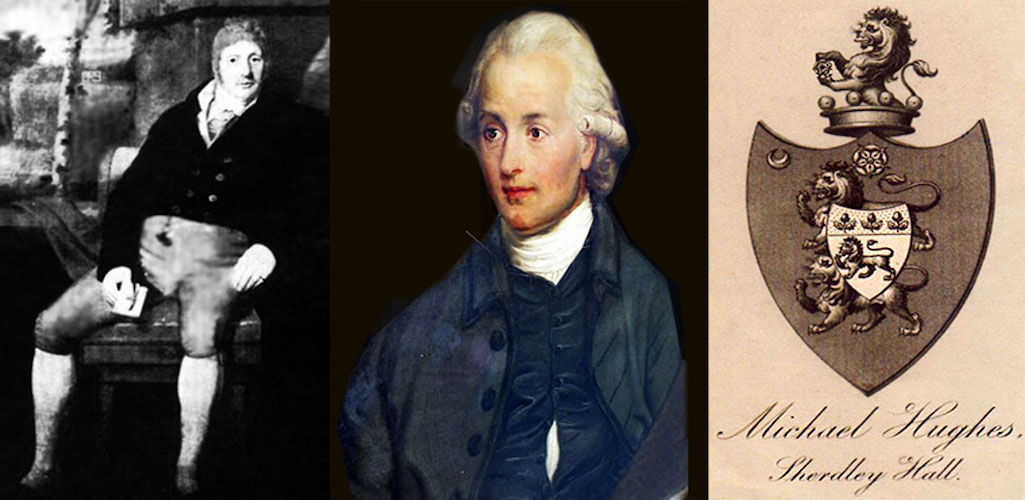
Left: Michael Hughes (1752-1825); Middle: Rev. Edward Hughes (x-1815); Right: Hughes coat of arms

Michael Hughes; Rev. Edward Hughes and Hughes coat of arms

Michael Hughes & Rev. Edward Hughes
Hughes prospered and from about 1795 began to acquire land. In 1797 he purchased Whitlow off John Drinkwater and in the following year he acquired the aforementioned large Sherdley Hall estate for £3,150 and then Leach Hall in 1800. In 1803 Hughes paid William Greenup £2,555 for the brick-fronted 'Old End' of the Costeth House estate (21¾ local acres) which was located near Sherdley Hall and he then negotiated to buy the stone-fronted 'New End'.
The Roughley family had purchased Costeth House in 1607 and in 1732 after the death of Thomas Roughley (d.1729), it was partitioned into two estates which were inhabited separately by Thomas's daughter Mary and his grand-daughter Esther. In 1820 Hughes formally exchanged an estate in Eccleston for the 'New End'. Although he lost £2000 on the deal, it didn't matter to Hughes as he was determined to possess all of the property within and around Sherdley Park.
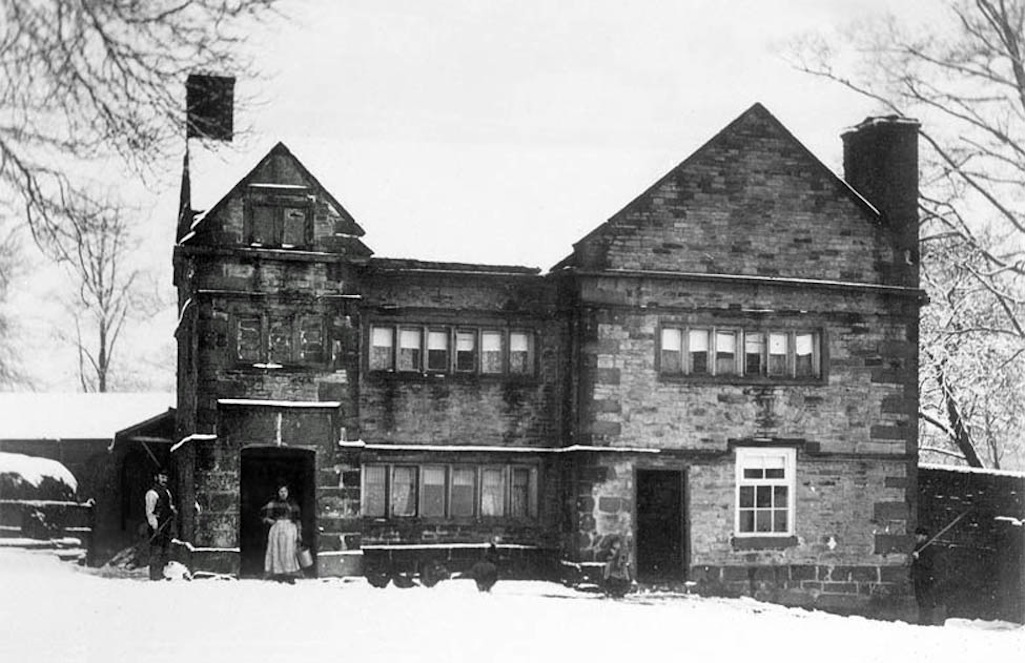
Sherdley Old Hall built about 1671 and photographed by R.G. Brook c.1890 (contributed by Lord St.Helens, Rory Hughes-Young)

Sherdley Old Hall built about 1671 and photographed c.1890

Sherdley Old Hall photographed c.1890
Hughes became a magistrate in October 1799 and was appointed a Deputy Lieutenant for Lancashire in 1806. He soon gained a reputation for his sympathetic handling of difficult cases and he often assisted the underprivileged from his own pocket. He donated £100 to the Liverpool Infirmary and during the grain shortage of 1800, Hughes gave contributions from himself and on behalf of the Parys Company for the relief of the Sutton poor. Michael Hughes' first wife died in 1798 and in 1807 he married Ellen Pemberton {x-1860}, the daughter of a neighbouring Sutton landowner. The couple had six children, including son and heir Michael Hughes (II) {1810-1886}. Hughes Jnr. was only fifteen years old when his father died on May 9th 1825 on a visit to London and so his mother Ellen initially managed the family estates.
Young Michael Hughes (II) was educated at Eton and Corpus Christi College, Oxford and then joined the army. He was promoted to Captain in February 1843 and served in the 3rd Royal Lancashire Militia. Hughes was a lover of sport and in a letter written to his mother in June 1854, declared his annoyance at the prospect of his regiment being posted to Ireland at the height of the grouse season:
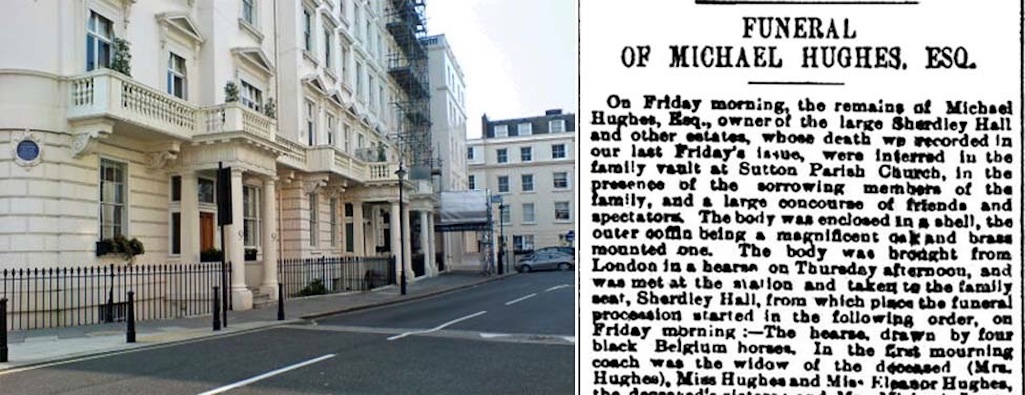
Left: 99 Eaton Place, London SW1; Right: St.Helens Newspaper report from May 4th 1886 on the funeral of Michael Hughes (II)

Left: 99 Eaton Place, London; Right: St.Helens Newspaper May 4th 1886

99 Eaton Place and funeral report
In 1873 Michael Hughes (II) - now a county magistrate - was recorded as owning 1,207 acres of land in Sutton but spent little time in St Helens. Sherdley Hall was rented out to tenants and in 1881 it was leased to coal proprietor James Radley who owned Lea Green, Sutton Heath and Nutgrove collieries. It was a 10 year lease and upon his death on March 28th 1885, the executors of Radley's estate had to advertise for a tenant so the contract could be completed.
In his later years, Hughes resided in London or at Huntly Lodge in Aberdeenshire. The Elgin Courier had reported on July 19th 1867 that the 'gentleman of landed property in Lancashire' was the new lessee of the Huntly Lodge shootings. On August 22nd 1874, the Morning Post singled out Hughes in their report on the Aberdeenshire shooting season, writing that he'd been averaging an impressive 21 brace a shoot on the Gartly and Balloch Hills.
On Hughes's death on April 24th 1886, the servants of the Scottish stately house sent a floral tribute to his funeral. Although the Sherdley Hall owner only made occasional visits to Sutton, he still paid attention to his estate and had recently helped his tenants during difficult times by reducing their rents. At the time of his death Hughes was the oldest county magistrate on the Lancashire list.
The will of the late Michael Hughes (II) was read in July of 1886 and his personal estate came to £82,000. Hughes's widow Ellinor was left his estates and their only child, Michael James, was left his plate. The young man would inherit the Sherdley estates upon his mother's death. By now the family had developed a military as opposed to an industrial tradition and Captain Michael Hughes (III) after being educated at Eton and Oriel College in Oxford spent 12 years service in the 2nd Life Guards. In 1893 Captain Hughes commanded a squadron in front of Queen Victoria for the trooping of the colour ceremony at Horse Guards Parade.
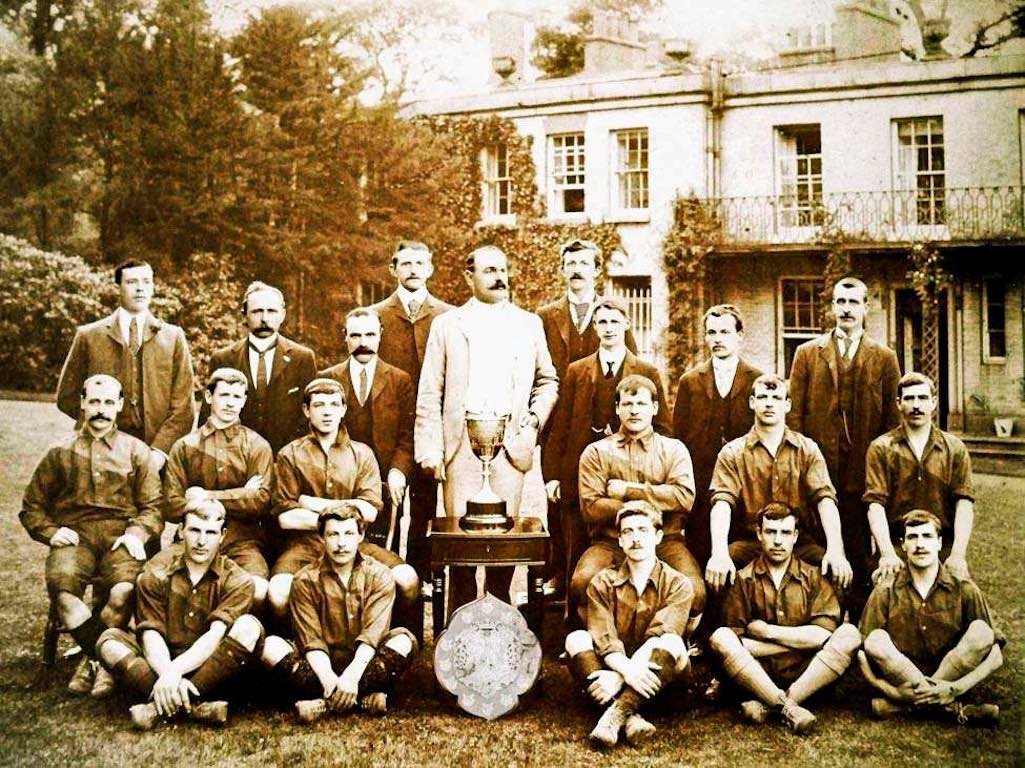
Michael Hughes III at Sherdley Hall with unknown sports team, probably late 1890s - contributed by Dianne Barton

Michael Hughes III at Sherdley Hall with an unknown sports team

Michael Hughes outside Sherdley Hall
On January 13th 1897 the couple held a ball and supper in Sherdley Hall, which was thought to be the first time that it had hosted such an event. The ball’s purpose was to allow the Hughes’s to meet their tenantry and receive their presentation on the occasion of their marriage. The hall was extensively decorated and illuminated with fancy lamps, lanterns and hundreds of fairy lights and its large dining room was converted into a ballroom, with music provided by Clayton’s quadrille band. Michael and Edith Hughes were presented with a magnificent silver tea tray produced by Elkington & Co., the renowned Liverpool silversmiths, which featured an allegorical treatment of a panther hunt. A suitably impressed Hughes told the gathering of 200 that it was the handsomest tray that he had seen and ‘as long as the house of Sherdley endures, that will be one of my most valued heirlooms’.
The Captain's retirement from the army didn't last long as he served in the Boer War from late February to November 1900. Just before he embarked for South Africa, Captain Hughes was presented with an inscribed service compass in a silver case. Dr. Henry Bates made the presentation at a fundraising concert on February 13th on behalf of St Helens Rugby Football Club, Sutton Cricket Club, Sutton Road Prize Band, Peasley Cross Football Club and St Helens Kennel Club.
These were all organisations that Hughes was president and the gift bore the inscription ‘Presented to our president, Captain Michael Hughes, on his leaving for South Africa’. He commanded various detachments, including a squadron of cavalry under General French in the advance from Pretoria to Komatipoort. Hughes received a hero's welcome when he arrived back at St.Helens Junction. A large crowd processed with him to Sherdley Hall, with Sutton's streets - including Robins Lane and Marshalls Cross Road - festooned with decorations. You can read a full account of his homecoming here.
In February 1902 Michael Hughes was sued for £3000 damages by Matthew Pimblett Pownall, a tenant of his Sherdley Estate who lived at Brookside Farm. The Great Sankey farmer blamed his landlord for a fire that had caused injury to his son and driven his wife into an asylum. In October 1896 there had been a fall of about a hundredweight of bricks from the farmhouse’s chimney into the room below. Pownall argued that he had reported the repairs to the Sherdley agent Henry Hunter Campbell but nothing was done. The fire which occurred in February 1899 was linked to damage caused by the fall of bricks some three years earlier. However Campbell and Hughes denied ever being told about Pownall’s chimney and the claim failed. During the hearing Hughes revealed that he received £3500 per year in rent from the farms on his estate, half of which was spent on repairs.
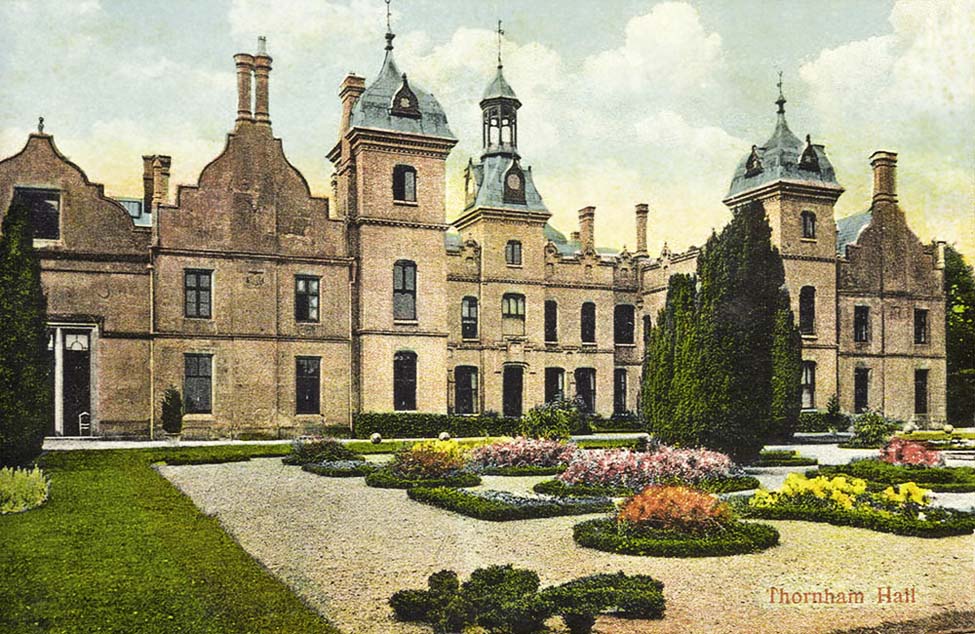
Thornham Hall had 95 rooms without heating and in one letter Edith dubbed it a "swamp", blaming her arthritis on it being so damp. The lease included the surrounding estate with 5 - 6 gamekeepers employed to raise game, including pheasants and partridges. These caused problems with neighbouring farms and the Sherdley estate agent who lived in Sutton Hall had to deal with many compensation claims. In 1906 Henry Bates became agent, replacing Henry Campbell, and he had to make many journeys to Suffolk.
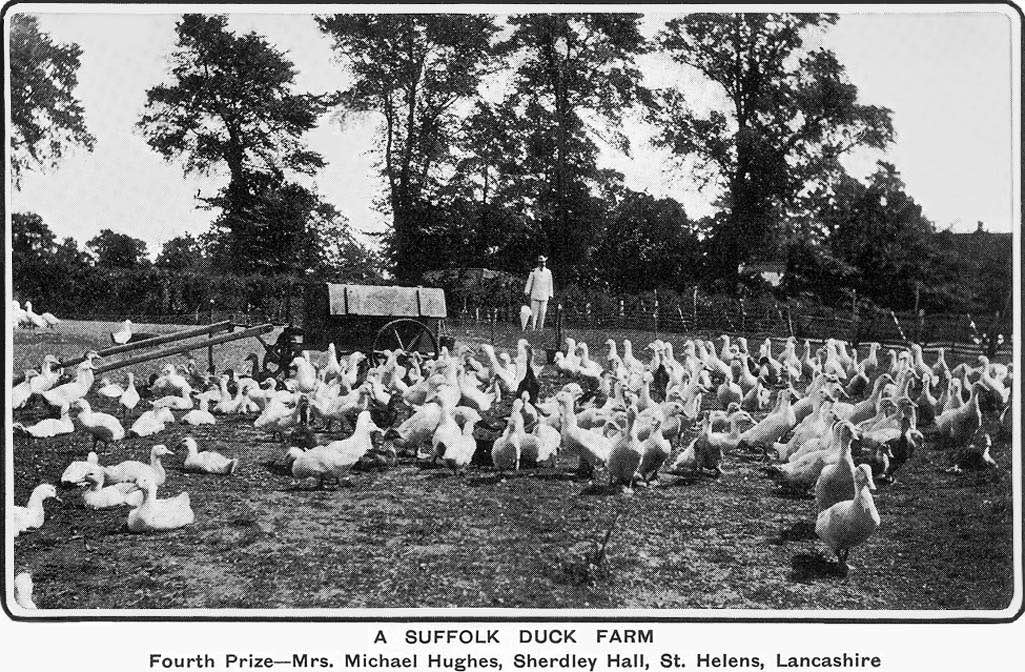
Consequently the couple's stays at Sherdley were of limited duration. When on the Riviera, they mixed with dignitaries such as Grand Duke Michael of Russia and Prince Albert Duke of Schleswig-Holstein. The latter was Queen Victoria's grandson and a guest at Thornham on several occasions. However Edith didn't care much for the Duke and in one letter referred to him as "beastly little Albert".
When the Great War broke out, the now Major Hughes served initially with the 10th Battalion Suffolk Regiment with 2500 men under his command. Too old to be involved in active combat, he was promoted on April 22nd 1915 to the temporary rank of Lieutenant-Colonel and sent to Ireland. Hughes succeeded in raising the 7th Battalion of the Royal Inniskilling Fusiliers at Tipperary, training mainly raw recruits and a number of St.Helens men served with him. Recruitment posters invited men to sign up at St Helens Town Hall.
The words ‘It’s a long way to Tipperary but it’s a lovely place when you get there’ were emblazoned at the top. Hughes' wife Edith went with him, residing at Aherlow Castle in Bansha and the couple remained in Ireland until Hughes relinquished command of his battalion on February 14th 1916. Back home, Sherdley Park was used during the war by the St Helens 'Pals' 11th Battalion of the South Lancashire Regiment for drill and exercises.
Michael Hughes believed strongly in punctuality and always arrived at engagements at precisely the appointed time, refusing to see visitors who were late for an appointment with him. In a letter to his Sherdley estate manager in 1911 he wrote:
In his younger days, he mixed intimately with royalty and was an outrider at the funeral of Edward VII in 1910. As a result of regularly wintering in southern France, Michael Hughes became fluent in French. In fact he claimed he was more comfortable in using the French language than English. When Sutton Harriers won the Vie au Grande Air Cup in Paris in January 1907, Hughes gave a long articulate speech in French to a large crowd. The Lancashire lads were reported to be dumbfounded by their club president's language dexterity in contrast to their own. When one of the athletes had wanted to order some milk in a Parisian café, he had to resort to imitating a cow to make himself known!
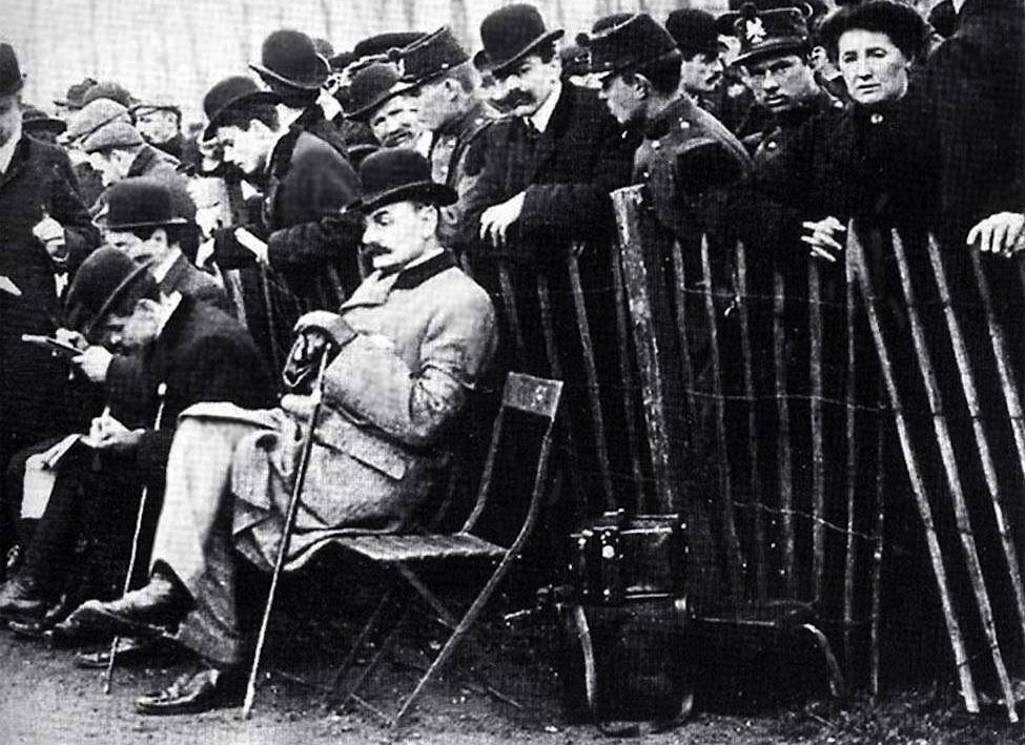
Michael Hughes (III) at St. Cloud in Paris in January 1907 seated and watching the victorious Sutton Harriers

Michael Hughes at St. Cloud in Paris in January 1907 watching Sutton Harriers

Michael Hughes in Paris in 1907
Only one horse, Rainhill (ran 1909-10), had a name with a local connection. Many horses were given French names, although he also had a liking for English names with a comic undertone, such as Mother-In-Law, Gals’ Gossip, Ugly Tights, Dik Dik and Orange Marmalade. Hughes's horse Aesop was probably his most successful, coming second in the 1893 Grand National and winner of the Grand Military Gold Cup in 1894.
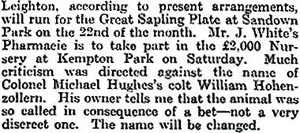
Owning racehorses was an expensive hobby. In one letter in 1914, Hughes revealed that he lost £1300 a year on his Sherdley horses. He regularly made £10 each way bets on them when racing and often paid large sums to acquire them. The Duke of Bewick cost him 620 guineas to buy in 1892 and in 1894 he paid 510 gns. for The Alsatian. On one day in December 1903, Hughes bought Wise Rosie for 780 gns. and a colt foal for 310 gns. However most of his Sherdley stock were bred from stud farms.
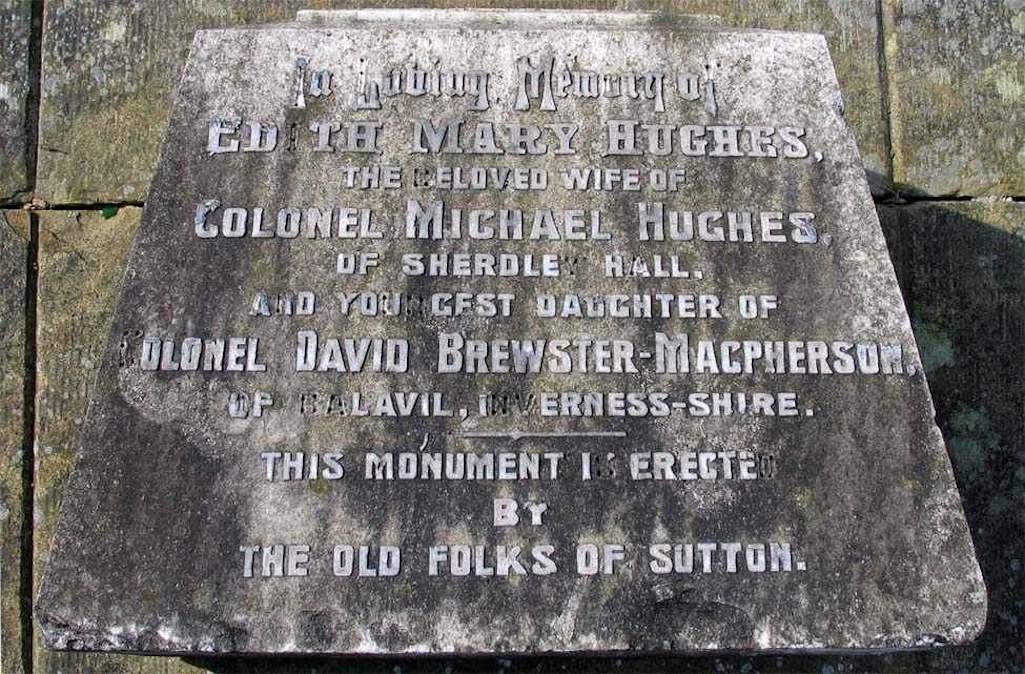
Monument to Edith Hughes, wife of Michael Hughes (III) in the graveyard at St. Nicholas Church

Monument to Edith Hughes which is in the St. Nicholas Church graveyard

Monument to Edith Hughes
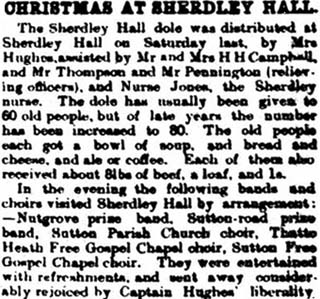
Edith and her husband provided a district nurse for the well-being of the estate's tenantry and staff who resided at Sherdley Hall. In 1899 it was Nurse Jones and in 1912 the nurse was Sarah Tither. Extracts from Sarah's notes have survived in which she lists patents, diseases, nourishments and stimulants given. The latter was mainly wine and the complaints that she was treating included catarrh, cancer, conjunctivitis, bronchitis and anaemia. Nurse Tither left in July 1918 to get married and Michael Hughes decided not to replace her due to the high cost of coal that was being burned in the Hall.
Every December Edith Hughes awarded the Sherdley 'dole' and large numbers of senior citizens had a more enjoyable Christmas through her largesse. In December 1914 there were 103 recipients. Consequently upon Edith's death in September 1922, a memorial to her was erected by the 'old folks' of Sutton in the graveyard of St. Nicholas Church. Hughes outlived his wife by 16 years, dying at Stowlangtoft Hall in Bury St. Edmunds in 1938. He'd moved to this house from Thornham Hall after the death of his wife.
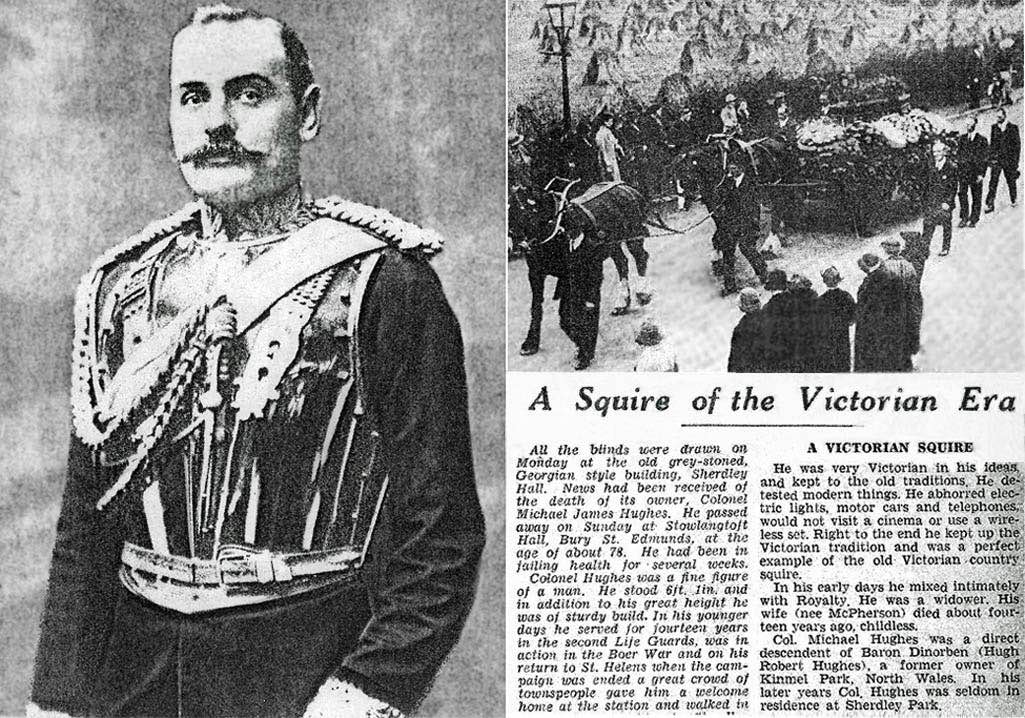
Left: Col. Hughes of Royal Inniskilling Fusiliers c.1915; Top right: Funeral procession; Bottom right: St Helens Reporter 26/8/1938

Left: Col. Hughes of Royal Inniskilling Fusiliers c.1915; Top right: Funeral procession; Bottom right: St Helens Reporter 26/8/1938

Col. Hughes and funeral procession
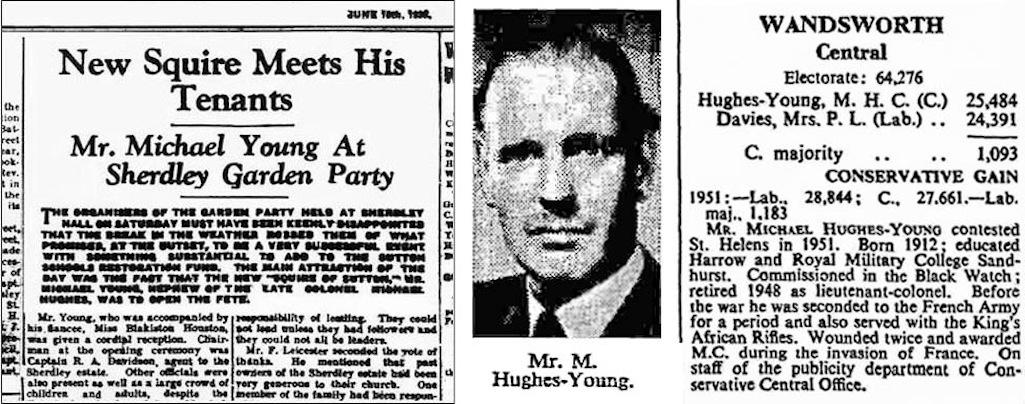
Left: St Helens Newspaper 10/6/1939; Middle: As pictured in election leaflets; Right: General election result in The Times 28/5/1955

Left: St Helens Newspaper report 10/6/1939; Middle: As pictured in election leaflets; Right: General election result in The Times 28/5/1955

St Helens Newspaper and Times reports
Michael Hughes-Young became another military member of the Hughes clan, rising to the rank of Lt. Colonel and during WWII was twice wounded and awarded the Military Cross. Sherdley played its part in the war effort with the cultivation of crops and the Air Ministry requisitioned Sherdley Hall for the duration. Stray bombs, which were thought to have been destined for the Liverpool docks, did some damage to the Sherdley estate, in particular Sherdley Home Farm, Micklehead Farm and Big Lea Farm.
On June 27th 1949, Hughes-Young sold Sherdley Park to St Helens Corporation for £18,700 before embarking on a political career. In the 1951 general election he became the Conservative parliamentary candidate for St.Helens but was predictably defeated, contesting a safe Labour seat. However Hughes-Young took Wandsworth Central in 1955 and when elevated to the House of Lords in 1964, he chose to take the title of Lord St.Helens.
Tragedy struck the family in 1970 when his heir, Captain Patrick Michael Hughes-Young, died in a riding accident. Younger brother Richard (Rory) Hughes-Young succeeded to the title of Lord St Helens in 1980 upon his father's death. Incidentally, Mt. St Helens, the volcano in Washington state, USA, is named after his 18th century diplomat namesake, Lord St Helens.
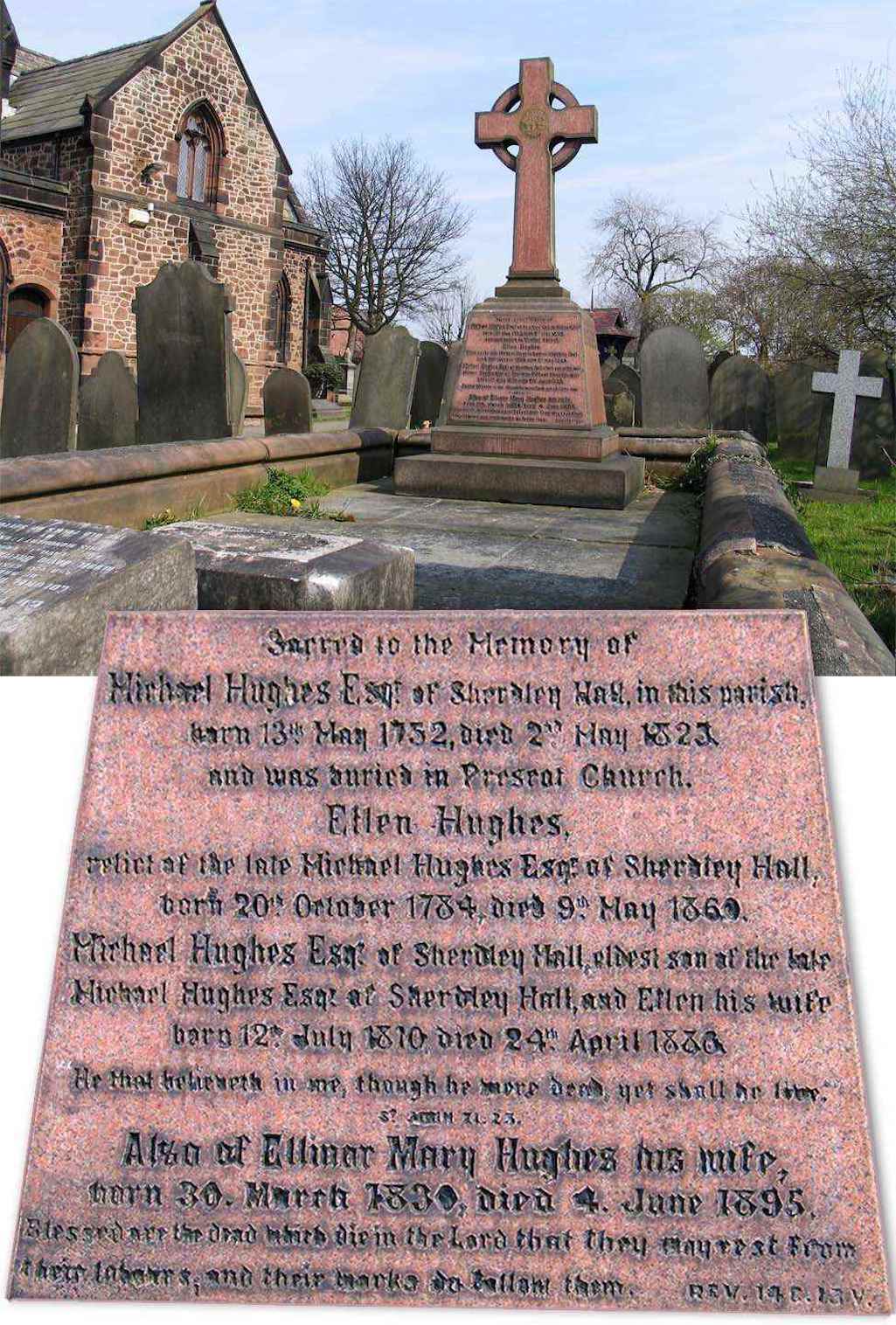
The Hughes family vault at Sutton Parish Churchyard in New Street, Sutton, St.Helens

The Hughes family vault at Sutton Parish Churchyard in New Street

The Hughes family vault at St.Nicholas
